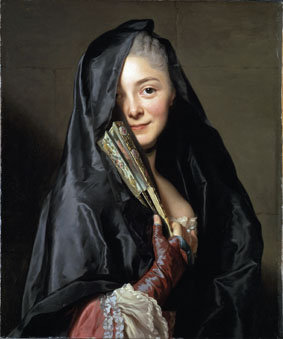Alexander Roslin
dal 26/9/2007 al 12/1/2008
Segnalato da
26/9/2007
Alexander Roslin
National Museum, Stockholm
During the second half of the 18th century, having one's portrait painted by Roslin was the height of social prestige. His paintings, focussing as they do on the superficial, on the elitist culture of the 18th century with its predilection for extravagance and luxury consumption, are in some ways reminiscent of the high-society mores of today.

Portraits
curated by Magnus Olausson
Many Swedes today know relatively little about Alexander Roslin, the painter who became Sweden’s most successful artist ever on the international arena. One of the aims of this exhibition is therefore to promote greater national awareness of his achievements and to place his work more firmly within the wider context of European art history. Alexander Roslin was an 18th-century Swedish portrait painter whose career – in Stockholm and the great art and cultural metropolises of Paris, St. Petersburg and Bayreuth – was nothing short of brilliant. During the second half of the 18th century, having one’s portrait painted by Roslin was the height of social prestige. His paintings, focussing as they do on the superficial, on the élitist culture of the 18th century with its predilection for extravagance and luxury consumption, are in some ways reminiscent of the high-society mores of today. The three exhibition halls are hung with over 100 portraits painted by Roslin during various periods of his life. The exhibition setting has been designed to suggest, in stylised form, the sort of environment in which Roslin lived and worked during the 18th century.
Visitors will be able to follow the artist’s progress from Skåne in Sweden to Italy and then to Paris, with trips on the side to Stockholm and St. Petersburg. Thanks to his artistic talent, his extensive network of contacts with the “right sort of people” and his unerring sense of timing, Roslin was able to move methodically forwards and develop both his art and his business. As soon as Roslin felt that he had nothing more to learn from his Swedish master, Georg Engelhard Schröder, he set his sights at Europe, with Paris his prime target. After a few years in Italy, he arrived in Paris, where, after only 18 months, he was admitted to the Academy of Arts. Roslin was enormously successful among members of French society and at his death in 1793 was the wealthiest artist in Paris.
The European élite of the day wished above all to distance itself from the rest of society; it was obsessed with ideals of beauty, with role play and the consumption of luxury goods. Roslin used his outstanding painting skills to portray the extravagant lifestyle of his patrons and did not hesitate to comply with their wishes. A distinctive feature of his work is his ability to reproduce, almost photographically, the clothes, accessories and powdered features of his subjects. Clothes and setting are an infallible guide to the status, wealth and occupation of the personage portrayed.
The Lady with the Veil is the work most familiar to Nationalmuseum regulars. However, the lady, with her mystical smile, is neither royal nor a member of society. She is Roslin’s wife, the artist Marie-Suzanne Giroust. An example of her work is also on show at the exhibition.
Press information
Director of Information Lena Munther lmr@nationalmuseum.se
Information Officer Anna Jansson ajn@nationalmuseum.se
Opening 27 september 2007
National Museum
Sodra Blasieholmshamnen, Stockholm
Admission Free



